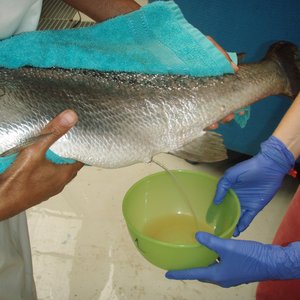eDNA, defined as any trace or fragment of DNA released from an organism into the environment, is proving to be an attractive tool in exploring and studying Earth’s biodiversity due to its non-invasive approach and relatively lower cost for sample collection and species monitoring. Genome BC has funded two projects to apply eDNA technologies to address challenges in salmon farming practices through improved environmental detection of problematic microbes, and to assess Pacific Salmon stocks.
Kudoa thyrsites (Kudoa) is an endemic parasite that can have appreciable economic impacts on the BC fisheries and aquaculture industry by decimating flesh quality. Due to the nature of the parasite and the enzymatic liquefying of fillets, the parasite lies undetected until production endpoints resulting in the costly wastage of farmed Atlantic salmon and some wild-caught species, such as hake.
Led by Wyth Marshall from the BC Centre for Aquatic Health Sciences and Tiffany MacWilliam from Mowi Canada West, researchers are looking to the novel application of Digital PCR (dPCR) to measure eDNA in aquatic microbes. In a project entitled “Application of digital PCR to measure eDNA from waterborne spores of an endemic fish parasite affecting farmed Atlantic salmon”, researchers will enhance the likelihood of earlier detection of these parasites and reduce the damage from Kudoa infections, thus improving the management of aquatic resources and increasing the adoption of this novel technology within the industry.
“We are really excited about this opportunity to add digital PCR technology as a new tool to reduce the impacts of Kudoa infections on the production of salmon,” said Marshall. “The strength of this technology is its capability to provide numerical abundance data which we can use to understand the ecology of very tiny or microscopic organisms that affect farming efficiency. The platform is broadly applicable and will improve understanding of the distributions and drivers of abundances of parasites like Kudoa, as well as other microbes that are detrimental to fish health, such as harmful plankton and jellyfish.”
The second project is led by researchers from Simon Fraser University and Gitanyow Fisheries Authority, Vicki Marlatt and Mark C. Cleveland respectively, and their project “Monitoring Pacific Salmon Stocks Using Environmental DNA” aims to create an efficient method of quantifying salmonids returning from the ocean to spawn. This analysis will produce a more accurate understanding of salmonids surviving upriver migration in five species of Pacific salmon. Researchers will quantify the number of fish passing a specific fish fence based on the eDNA samples collected from the Kitwanga River and compare this information with traditional salmon counting methods at the facility. Advancing the tools used for monitoring Pacific salmon populations is critical in understanding the health and abundance of these species and studying their role in ecosystems, as well as their cultural and economic value to humans.
“eDNA has unique applications and we are only just beginning to realize the potential of this novel approach to analysis and sampling,” said Lisey Mascarenhas, sector director, Agrifood and Natural Resources at Genome BC. “We are also very pleased to support applied research that enhances the awareness, adoption, and operationalization of genomic solutions for the benefit of key economic sectors in BC.”













